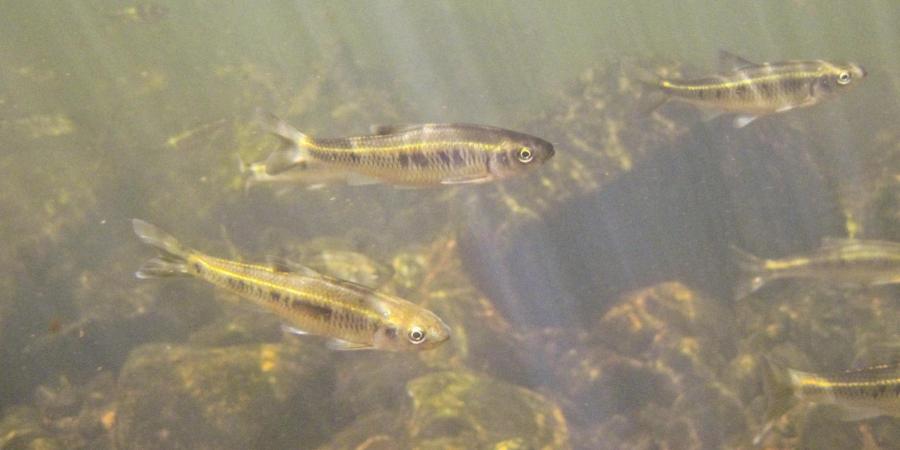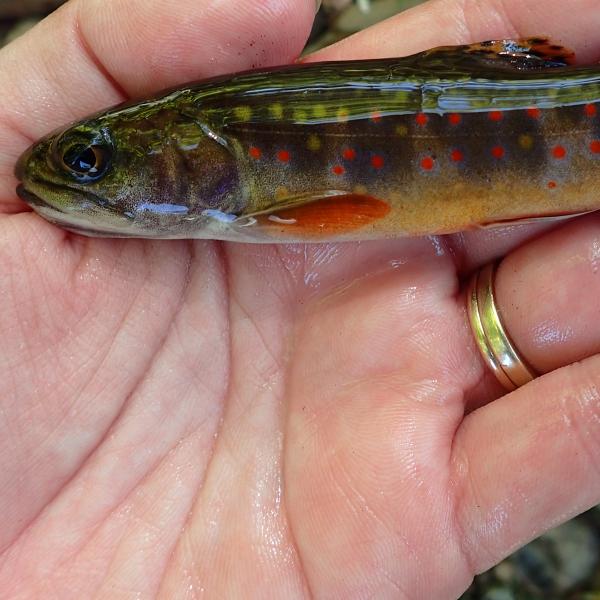The Ausable watershed encompasses 512 square miles, 27 High Peaks, and includes 94 miles of river channel fed by more than 70 streams. It is home to over 20,000 human residents living primarily in settlements downstream of its protected headwaters. The watershed comprises a diversity of ecosystems, from the boreal wilderness of Mt. Marcy and the High Peaks, along the Sentinel and Giant Mountain Wildernesses, down to the lowland valley of Lake Champlain. This diversity of lush forest, fertile valleys, and protected wilderness creates extensive wildlife habitat that hosts a range of species: fisher, black bear, bobcat, snowshoe hare, ermine; palm warblers, Bicknell's thrush, rusty blackbirds, black-backed woodpecker, spruce grouse, and saw-whet owls; spotted salamanders, American toads and more. The diversity in aquatic habitats likewise allows for a range of aquatic species from zooplankton to macroinvertebrates to fishes.
Small but significant: four native fish
The Ausable is home to more than 60 species of fish. They live in the streams, rivers, ponds, and lakes of the watershed – sometimes in the smallest trickle of water. Some are very specialized, requiring particular habitats, while others are more adaptable to a wide range of environmental conditions, and are thus found throughout the watershed. In an earlier article, we took a close look at the pearl dace, longnose dace, creek chub, and white sucker. Today, we will examine the lives of blacknose dace, brown bullhead, tessellated darter, and round whitefish.
Blacknose Dace (Rhinichthys atratulus)

Illustration of blacknose dace by E. Edmonson and H. Chrisp, artists with the 1926-1930 New York State Conservation Department Surveys.
The blacknose dace is one of the most common minnow species found in the Ausable River and its tributaries. All dace species are known for their small, fine scales, and the blacknose dace is most distinguishable by the dark lateral band that runs from the tip of its head through the eye and along the body to the tail. When their spawning season occurs in late May, the fins of the males turn a rusty color. A small minnow, their total length is only 2-3 inches. They feed upon mostly insect larvae, small crustaceans, and plants.
Pearl dace are widely distributed in Canada and the northern latitudes of the United States, and prefer habitats found in small lakes, cool ponds, and spring-fed creeks. They are spring breeders, establishing and defending a small streambed territory for wandering females to lay eggs in. They are common in the pools of streams, and they prefer cool clear water with a gravel substrate. They live for 2 to 3 years and are native to the Adirondacks and New York State.
Brown Bullhead (Ameirus nebulosus)

Illustration of brown bullhead by E. Edmonson and H. Chrisp, artists with the 1926-1930 New York State Conservation Department Surveys.
Brown bullhead are the most abundant member of the catfish family living in the Adirondacks. They are smaller than the large channel catfish that frequent the main stem Ausable River near Lake Champlain. Growing to sixteen inches in length and weighing up to 2 pounds, brown bullhead are omnivorous and eat plant matter and animals. These long slender fish have mottled brown to black coloring, with a square-shaped tail and dark whisker-like barbels around their mouth. The barbels are covered with sensitive chemical receptors that help the brown bullhead find prey in dark or murky waters. In fact, they are most active at night.
Brown bullhead are widely distributed across northern North America and their range extends south to Florida. They prefer to live in the ponds and lakes of our watershed, and they spawn in early summer in shallow warm waters. The males of this species are the nest builders, but the females incubate the eggs by agitating the nest with movement from her tail and fins. Once hatched, both parents exhibit parental care, acting like shepherds to keep the pod of young bullheads swimming together for safety.
Support our biodiverse habitats work for aquatic species and their habitats. Give with confidence today!
Tessellated Darter (Etheostoma olmstedi)

Illustration of tessellated darter by E. Edmonson and H. Chrisp, artists with the 1926-1930 New York State Conservation Department Surveys.
Another native fish of New York, the tessellated darter is a wonder to observe in the stream or an aquarium. They live up to their name, and dart quickly from rock to rock at the stream bottom. They use their pectoral fins to sit low on the bottom waiting for drifting insects or debris to feed on. They are an important item in the diet of different trout species that live here, too. Tessellated darters are long and slender, growing to 3 inches in length as adults. They can be identified by the 9 to 11 W, M, or V-shaped dark colored markings that run in a horizontal row along their sides. Their bodies, behind these marks, are the color of sand and this helps them blend into our Ausable River and streams quite well.
Tessellated darters usually prefer swift water and sandy stream bottoms, but they move to rocky stream areas for spawning. As spring spawners, the males of this species are extremely territorial. The females lay eggs on the underside of rocks, and the male remains in the area to keep guard and fan with his tail to keep water circulating over the eggs. This species is native to the region and is found from North Carolina north to the St. Lawrence River.
Round Whitefish (Prosopium cylindraceum)

Illustration of round whitefish by E. Edmonson and H. Chrisp, artists with the 1926-1930 New York State Conservation Department Surveys.
Once a very common resident of deep and cold Adirondack lakes, the round whitefish is now only present in a few water bodies and is considered endangered by the state of New York. The Ausable watershed is home to some of the few remaining naturally reproducing populations of these cold-loving fish. They are a species of the Salmonidae family, and have the characteristic adipose fin and long slender body. When compared side by side with trout or salmon, whifefish are distinguishable by their larger scales and small mouths. Round whitefish have a particularly long, round, body, and are silvery gray in color, but can exhibit a blue, green-yellow, or purple sheen on their sides. The young of this species have several rows of black spots on their sides.
Round whitefish grow up to 14 inches long and spend most of their time in deep water (up to 150 feet). They feed on plankton, invertebrates, and mollusks. They enter shallow waters for spawning over gravel beds in late fall, usually after the frost and first layer of ice is forming on lake edges. For this reason, they have received the nickname of frostfish.
This species has experienced sharp declines across New York State over the past two to three decades that are attributed to lake acidification, siltation of spawning areas, and competition and predation from introduced species such as bass. Learn more about NYS DEC restoration of this species here.
Find out more about native fishes in the informative guide: Freshwater Fishes of the Northeastern United States by Robert Werner (2004).





